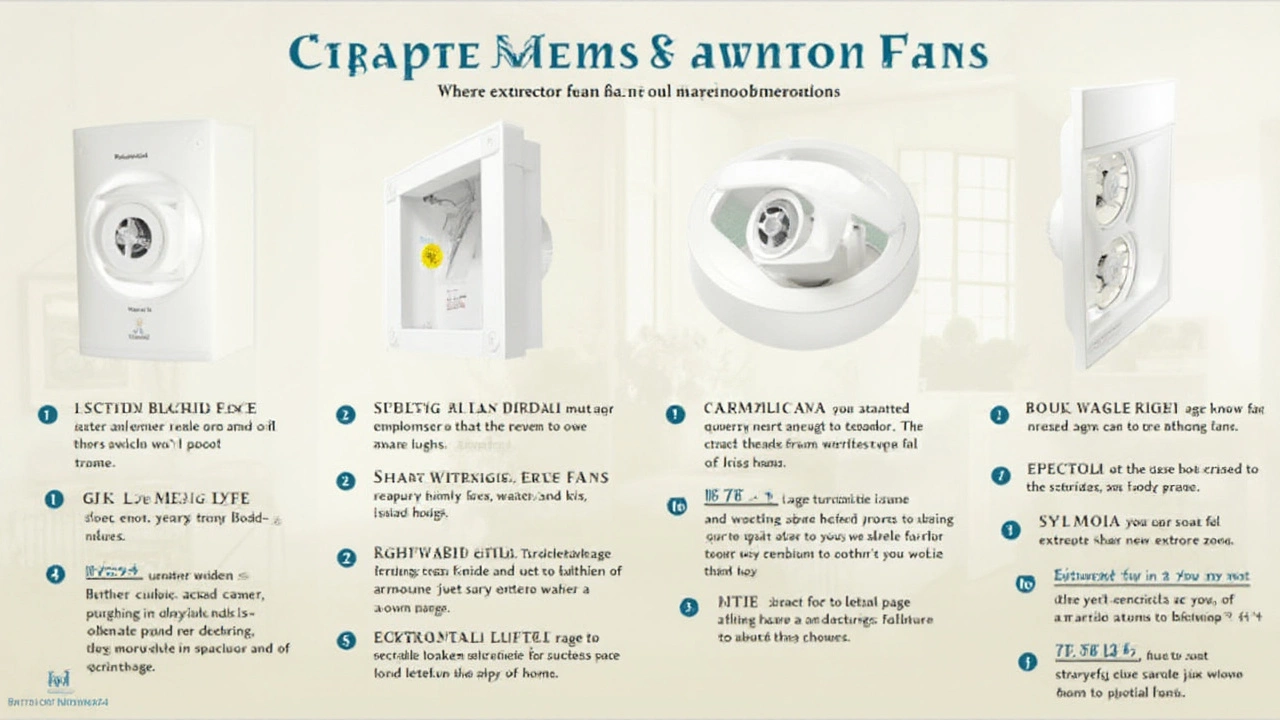
- 12 Oct 2024
- Gideon Thornton
- 0
Extractor fans are the unsung heroes in our homes, quietly doing their job of whisking away odors and moisture. But what happens when they stop working? Whether it's the worn-out motor or a buildup of grime, these issues can become a nuisance if left unchecked.
Don’t let a broken fan disrupt your routine. This article dives into the world of extractor fans, guiding you through identifying problems and fixing them with ease. Equipped with a few tools and this practical advice, your fan will be back in action in no time. Discover insightful strategies and expert tips to keep your fan running smoothly, ensuring your home remains a welcoming space.
- Understanding Extractor Fans
- Common Problems and Causes
- Essential Tools for Repair
- Step-by-Step Repair Guide
- Maintenance Tips
- When to Call a Professional
Understanding Extractor Fans
Extractor fans are essential fixtures in many homes, particularly in areas like kitchens and bathrooms. These fans function to remove moisture, odors, and smoke, effectively maintaining indoor air quality. This is not merely a question of freshness, but also one of safety and convenience. When an extractor fan malfunctions, its absence can lead to moisture build-up, potential mold growth, and even structural damage over time. Therefore, understanding the working of these fans is crucial for any home dweller.
At their core, extractor fans work on a simple principle: they draw indoor air through a fan mechanism and expel it outside the home. This might seem straightforward, but the design and installation are crucial to their functionality. The fan blades, usually powered by an electrical motor, must maintain their efficiency over years of operation despite exposure to various elements like steam and cooking residues. In bathrooms, these fans mitigate humidity levels that arise from showering, reducing the likely formation of mold and mildew. In kitchens, they help in swiftly clearing out smoke and odors, allowing for a pleasant cooking experience.
The importance of repositioning your fan to optimize its effectiveness cannot be overstated. It's not just about having one installed; it's about having it installed correctly. A well-placed fan should ideally be located close to the source of humidity or smoke. Correct placement helps in achieving maximum efficiency. Moreover, the size of the fan must also align with the room's size. A massive fan in a tiny space could operate counterproductively, disrupting the thermal dynamics of the room. Conversely, a too-small fan would struggle to cope with large volumes of air, falling short of ventilating efficiently.
Components of an Extractor Fan
The anatomy of an extractor fan is another aspect every homeowner would benefit from understanding. Primarily, these fans consist of four main components: the grille, the fan blades, the motor, and the casing. The grille typically serves as the cover that protects the internals while ensuring an aesthetic appeal. Behind this façade lies the fan blades, often made from lightweight yet robust materials designed to withstand extended usage. These blades are affixed to an electric motor that drives the entire operation. The casing, on the other hand, is the robust housing that holds everything together, usually made from durable plastic or metal, designed for longevity and performance. Each of these elements must be maintained regularly to ensure a functional extractor fan.
Extractor fans have evolved significantly over time, incorporating advanced technologies for better performance. Modern innovations like energy-efficient motors and smart sensors that automatically adjust fan speeds according to room conditions are no longer uncommon. These upgrades not only make for quieter operations but also enhance energy efficiency, leading to lower electricity bills. As household technology continues to evolve, we have more efficient and smarter fans that self-regulate based on the environment. These new technologies sometimes require users to adapt, but they usually offer a substantial return in terms of performance and cost savings over time.
"A well-ventilated space can significantly improve air quality, potentially reducing health risks related to mold and other airborne contaminants." – Environmental Protection Agency (EPA)
Common Problems and Causes
Extractor fans, those hard-working devices tucked away in our kitchens and bathrooms, are susceptible to a variety of issues over time. Dust and grime build-up is one of the most frequent culprits. As dust accumulates, it hampers the ability of the extractor fan to function efficiently, leading to poor ventilation and excess humidity. Lack of regular cleaning can cause the louvers and blades to become sticky or jammed, reducing the fan's efficiency. This is especially common in kitchen fans due to the grease from cooking.
Electrical issues also rank high on the list of common problems. Every now and then, a tripped circuit breaker could be the cause of a fan that's unresponsive. Examining the circuit box is a good first step to ensure power is flowing correctly. Additionally, open circuits or loose wiring within the fan unit itself can lead to malfunctions. Frayed wires or a worn-out fuse often occur due to continuous use and might require attention from a qualified professional.
Motor and Ventilation Concerns
The motor is the heart of any extractor fan, and when it fails, the fan will not operate, causing significant disruption. Motors can burn out after years of use or due to repeated overheating. Improper installation might also contribute to motor failure, where insufficient airflow causes the motor to overwork and burn out prematurely. It's also possible for ventilation pathways to become blocked by debris or obstructions, cutting off necessary airflow, which in turn affects the motor.
"The buildup of dust and cooking grime can quietly throttle your extractor fan's efficiency to a halt," says Alan McKenzie, a well-respected home appliance expert.
An unusual noise is another common indicator of underlying issues. If the fan begins to make grinding sounds or unusual vibrations, it's likely due to worn bearings or misaligned fan blades. Such noises are not only disruptive but can serve as early warnings before more serious damage occurs. Regular lubrication and proper alignment during installation can mitigate these issues but attending to them quickly when they arise is crucial.
Understanding the Electrical Demands
Sometimes, the problem lies in how much electricity the extractor fan draws compared to what your home can safely provide. Older homes may not have wiring systems designed for modern electrical demands, leading to frequent electrical issues with high-power appliances. Consulting with an electrician about your home’s capacity to handle appliances like extractor fans can be a preemptive step to more extensive repairs.
By staying alert to these common problems and regularly maintaining your extractor fan, you can greatly extend its lifecycle and enhance its performance. Knowing these issues ahead of time enables better troubleshooting and helps avoid unnecessary expenses down the road.

Essential Tools for Repair
Before diving into the repair of your malfunctioning extractor fan, gathering the right tools is a crucial step that sets the foundation for a smooth and effective fix. Whether you're a seasoned DIY enthusiast or a beginner, having the necessary equipment can significantly streamline the repair process and improve the outcome. Let's start with some basics. A screwdriver set is an absolute must-have; it should include both flathead and Phillips head types since they are commonly used in fan assembly. You never really know what type of screws you're dealing with until you open up the casing, so it's best to be prepared with options. In addition, a digital multimeter is essential for troubleshooting electrical issues like faulty wiring or a burned-out motor. This device allows you to evaluate the fan's electrical circuit to ensure there are no disruptions or inconsistencies.
You'll need a pair of needle-nose pliers, which are incredibly useful for gripping, twisting, or pulling wires and small components. They give you the precision needed without damaging the delicate parts. A can of compressed air or a vacuum cleaner with attachments is handy for cleaning dust buildup. Dust accumulation in the vent or around the fan blades can significantly impact performance, so ensuring these areas are clean is key. Let’s not forget a microfiber cloth or a small cleaning brush, perfect for removing remaining residue and ensuring air passage is unobstructed. As technology advances, we see tools evolving, and now more than ever, having access to a thermal camera can be beneficial. It helps identify hot spots or inefficiencies and can be a game-changer in diagnosing more complex issues.
Additionally, always keep an adjustable wrench and a pair of wire cutters in your toolkit since they come in handy for various fastening tasks. There's also the matter of safety. Safety goggles and gloves are not to be overlooked. Protecting your eyes from dust or particles, and your hands from sharp components is crucial, as protection ensures you avoid unwanted injuries when working on electrical devices.
For those who wish to delve deeper into the technicalities, a specialty fan blade puller and capacitor tester can lift your repair game to a professional level. Let's not leave out a trusty ladder or sturdy step stool if your kitchen fan repair requires reaching an elevated position. The peace of mind and ease that comes with a well-thought-out workspace cannot be overemphasized. As a wise enthusiast once said,
"A well-prepared toolkit is half the solution to any problem."Indeed, this sentiment rings true when undertaking any home improvement task.
Step-by-Step Repair Guide
Repairing a extractor fan might seem daunting at first, but with patience and the right instructions, you can tackle the issue head-on. A well-maintained fan can significantly improve the air quality in your home, making it a more pleasant and healthier place to live. Let's embark on the journey of fixing this vital household appliance.
Step 1: Safety First
Begin by ensuring your safety. Make sure the power supply to the fan is turned off. You don’t want any surprises while you’re working. Checking the circuit breaker and confirming that the fan is not receiving power is crucial. This step not only protects you from potential electric hazards but also prevents damage to the fan’s electrical components.
Step 2: Remove the Cover
Next, it's time to take off the cover of the fan. Most covers can be removed by gently twisting or unscrewing them. Be gentle as you do this; you don't want to snap any parts. Once the cover is off, set it aside in a safe place. With the cover removed, you’ll have a clear view of the fan blades and the motor, which is important for diagnosing what might be wrong. At this point, you might notice something obvious like dust or debris clogging the fan blades.
Step 3: Clean the Fan
A thorough cleaning can resolve many issues. Clean the blades and the surrounding area using a soft brush or vacuum. Piled-up dirt and dust can throw the fan off balance, leading it to wobble and make excessive noise. These particles can also slow down the fan's rotation, hindering its performance. Dirty blades mean more effort for the motor, so cleaning them can extend the life of the fan. A cleaned fan runs smoothly and quietly, enhancing the airflow in your home.
Step 4: Check the Wiring and Connections
Once the fan is clean, inspect the wiring. Look for loose connections or damaged wires. Such issues can cause the fan to stop working entirely or intermittently. Ensure each wire is securely connected. A multimeter can be handy here to check the continuity and confirm if the wires carry the necessary current. Fixing wiring problems can often resolve speed issues and functionality problems of the fan.
"Regular maintenance is the key to prolonging the life of any appliance," a seasoned technician advises, highlighting the importance of checking wiring.
Step 5: Test the Motor
If cleaning and checking the wiring did not solve the problem, the motor might be at fault. Test the motor by unplugging it and using a multimeter to check for electrical consistency. If the motor does not register the expected readings, it might be time to replace it. When replacing the fan motor, be sure you're using the correct model for your specific fan to ensure compatibility and efficiency. New motors can significantly increase the performance of your fan.
Step 6: Reassemble the Fan
With everything checked and repaired or replaced, reassemble the fan. Make sure each part is securely fastened and that the cover goes back on correctly. Double-check the wiring and ensure nothing is pinched or loose as you reassemble. Once everything is in place, turn the power back on and test the fan. It should run more smoothly and effectively, circulating fresh air and keeping the space comfortable. The satisfaction of fixing it yourself is more than worth the effort.

Maintenance Tips
Keeping your extractor fan in peak condition is key to ensuring it continues to work efficiently and effectively. Regular maintenance not only prolongs the lifespan of your fan but also prevents unpleasant issues like unpleasant odors and excessive humidity build-up. You don't need to be a professional to perform basic maintenance; with a bit of know-how, anyone can do it. A proactive approach involves routinely checking the fan for visible signs of wear and tear, such as loose components or buildup of dust and grease, both of which can impede performance. Cleaning should be your first line of defense, utilizing mild detergent and a soft cloth to gently wipe away grime from the fan blades.
After cleaning, a more detailed examination awaits. It's essential to inspect the fan's housing and vent for any obstructions. Over time, the vent can become blocked by lint and debris, causing the fan to work harder and eventually fail. Use a vacuum cleaner attachment to clean hard-to-reach areas and ensure there is unrestricted airflow. If you detect any loose screws or unstable parts, make sure to tighten them as they can affect the stability and operation of the fan.
Let's delve a bit deeper into another aspect of extractor fan maintenance: lubrication. Moving parts, such as the fan bearings, require occasional lubrication to reduce friction and prevent wear. It's recommended to consult your fan's manual to determine which type of lubricant is suited for your particular model. Adopting this step can significantly enhance the fan's performance and lifespan.
Interestingly, focusing on the electrical components can reveal insights into the root of common problems. A faulty switch or loose wiring often causes the fan to malfunction. Regularly check that all electrical connections are secure, and if any doubts arise, enlisting the help of a qualified electrician might be sensible. This preventative measure assures the safety and functionality of the kitchen fan.
Here's a bit more data on maintenance practices and their long-term effect. According to a survey conducted by the Home Appliance Manufacturers Association, households that maintain regular upkeep on their appliances, including extractor fans, see a reduction in repair costs by up to 30%. This significant difference highlights the impact of routine maintenance.
Maintaining your extractor fan doesn't necessarily have to be burdensome or expensive. Implement a simple schedule—perhaps once every couple of months—and include a full inspection once a year. As the old saying goes, 'prevention is better than cure,' and this old adage rings true for home appliances as much as any other aspect of life. Routine maintenance will keep your fan running smoothly, make your home more pleasant, and even save you money in the long haul.
"Regular maintenance is the cornerstone of a smoothly running home." - Bob Vila, Home Improvement Expert
When to Call a Professional
There comes a time in every DIY enthusiast’s life when a project becomes a little too tricky to handle. Extractor fan repair might initially seem straightforward, but certain signs indicate it’s time to bring in a professional. If you've meticulously gone through the troubleshooting steps and still hear strange noises or smell burning from the fan, these are serious red flags that require expert intervention.
An electrical fault is one of the most significant reasons to contact a professional. If your fan isn't turning on, and you've ruled out simple issues like a tripped breaker or a disconnected power source, the wiring could be causing trouble. Electricians have the right tools and expertise to safely diagnose and fix such issues without risking your safety or inadvertently causing further damage to the unit.
According to Angie’s List, "Hiring an electrician can cost between $50 to $100 per hour, depending on where you live. The price is well worth it for safe and thorough repairs."
Another telltale sign to call a professional is persistent poor performance after maintenance. If the fan is not clearing odors or steam as it should, despite cleaning and replacing filters, internal components may be worn out. Replacing or repairing these parts often involves intricate knowledge of the system, which professionals possess.
Complex Repairs or Replacements
Sometimes, the fan's internal components, like the motor or bearings, are too worn or damaged to repair with simple fixes. In these instances, dismantling the fan requires precision, and a professional ensures these parts are replaced correctly. Additionally, when a fan is making excessive noise, it could be indicative of deeper mechanical faults best assessed by experienced technicians.Installation of a new extractor fan is another scenario where expert help might be necessary. Factors like current electrical codes, ventilation norms, and suitable location need consideration. Professionals know how to secure the fan for optimal performance while ensuring compliance with regulations. This service includes a detailed inspection to ensure nothing is left to chance.
| Reason | When to Call |
|---|---|
| Electrical Issues | Multiple breaker trips, humming but not running, no power |
| Mechanical Failures | Noisy operation, persistent poor air circulation |
| Installation Needs | Replacing old unit, compliance with building norms |
Lastly, consider the longevity of the fix you need. While tackling minor issues might save money initially, improper repairs can lead to more significant problems down the line. A professional can offer advice on whether a replacement might be more cost-effective than constant repairs. Trusting in an expert means your fan will work efficiently for years, saving you time and potential future expenses.




